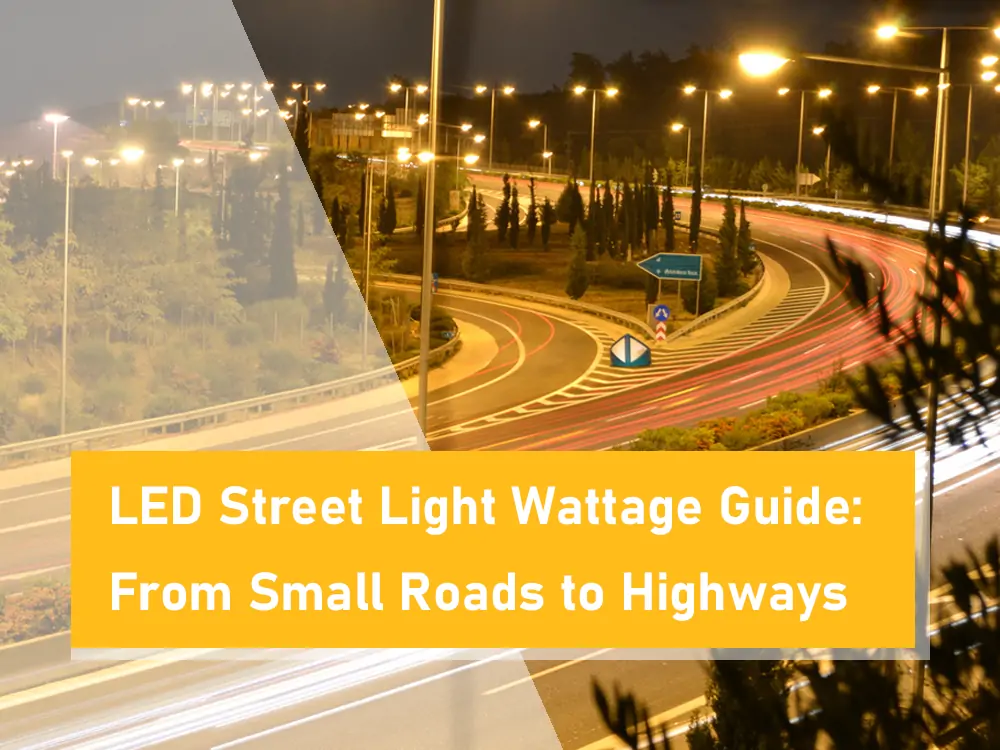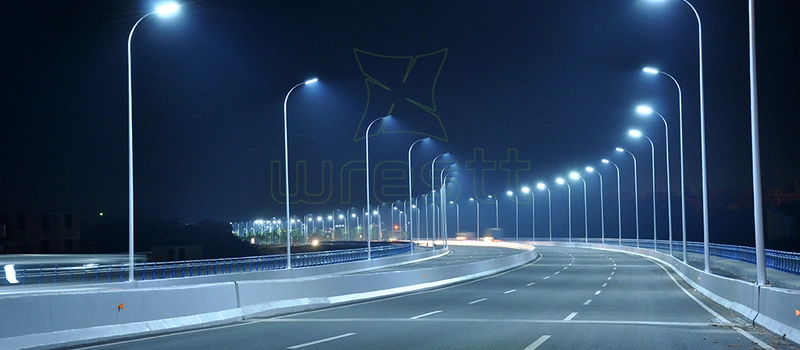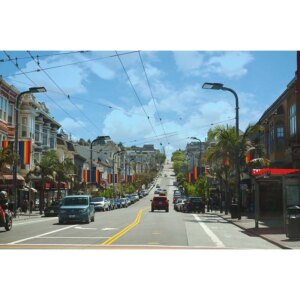Introduction:
Depending on the application, the right LED street light selection means the right wattage.
Wattage is not just a number. It provides the right illuminance, safety, cost-saving, and sustainability. Selecting the correct number transforms your lighting project.
So, you get 30–300 watt light sources for different LED street light applications. Which one to choose? Various factors are involved in selecting the right LED street light wattage. This guide is all about eliminating this confusion.
In this guide, you’ll understand the wattage for street lights and the correct wattage for various applications. Also, we’ll discuss all the factors that impact the wattage of these street lights. So, let’s start with the basics.
Understanding LED Street Light Wattage
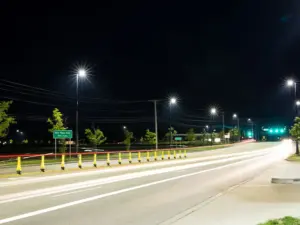
What is the Wattage in LED Street Lights?
The power that the light consumes is wattage. Higher wattage reflects more electricity consumption, but results in more brightness.
Now, LEDs are replacing the older alternatives. So, low-wattage lights now give the same high brightness, meaning LEDs are much more efficient. This efficiency is due to better light conversion – LEDs waste less energy as heat.
Typical Wattage Ranges
Here are some wattage ranges used for LED streetlights.
30- 60W: It is good for lower lighting requirements.
80- 120W: It provides moderate lighting.
150- 200W: This higher wattage is suitable for bright lighting needs.
250- 300W: This wattage gives a high level of brightness.
Calculating LED Street Light Wattage
Here is the basic formula to calculate the correct wattage for streetlights.
Required Wattage = Luminous Flux (lumens) / Luminous Efficacy (lm/W),
where luminous flux depends on your area and desired brightness
Factors Influencing LED Street Light Wattage
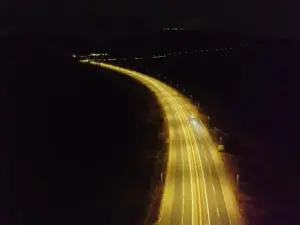
Application Area
Area plays an important role here. Different locations have different wattage requirements. Usually, residential streets only need low wattage. And that within 30-60 watts would be enough. City streets, however, receive 60-100 watts. In large roads and industrial areas, use 100-200 watt lights. The particular requirements for any area depend on traffic and the safety level.
Pole Height and Distance
Taller poles need higher wattage lights to reach the ground effectively. For example, 10 watt LEDs work well on 2.5- 3-meter poles. In contrast, poles between 3-4.5 meters tall need 15-20 watt lights. The distance between poles also matters. Wider spacing means each light needs more power to prevent dark spots between fixtures.
Road or Area Width
Wider roads require more powerful lights to cover the entire surface. On a narrow path, 30 watts can be enough. On the contrary, it takes 150-200 watts or more to burn a 4-lane highway efficiently. The width directly affects how much area each light must cover.
Luminous Efficacy
It is a measure of how efficiently the conversion of electricity into visible light takes place (lumens per watt). Therefore, it directly affects the power requirement. Higher efficacy LEDs (100-200 lm/W) require less wattage. At the same time, these produce the same brightness as traditional lights.
Required Brightness (Illuminance)
The needed brightness level, measured in lux, drives wattage selection. Areas requiring higher visibility, like intersections, need brighter lights with higher wattage. While less critical areas can use lower wattage options while still maintaining safety standards.
Light Distribution and Uniformity
Higher-wattage LED street lights often provide better light distribution. This ensures even lighting across the entire area. In contrast, Poor distribution creates dangerous dark spots between lights. So, the right wattage helps maintain consistent illumination throughout the space.
Energy Efficiency Goals
Higher wattage means light, but with that, more electricity is consumed. Many cities aim to reduce energy use while maintaining proper lighting. LED lights already use 50-70% less energy than traditional options. Choosing the optimal wattage further improves these savings.
Maintenance and Operating Costs
When it comes to costs, wattage makes immediate and long-term expenditures. However, fixtures with higher wattage are more expensive in the first place. However, they may make it possible to achieve greater coverage with a smaller number of lights. Optimal lighting wattage range also extends their lifespan, reducing replacement frequency.
Local Standards and Regulations
Many areas have specific lighting requirements for different zones. These standards often specify minimum illumination levels, which directly affect wattage needs. So, always check local regulations before selecting street light wattage to ensure compliance.
Considering these factors, you’ll get the wattage just according to the application. As a result, perfect illumination will be achieved with maximum energy efficiency and cost savings.
How Many Watts are Streetlights for Different Applications?
Different applications need different wattage. So, here is a detailed overview of some applications and required wattage.
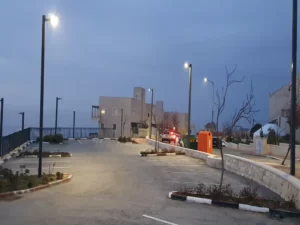
30- 60W: Residential and Small Road Lighting
These lights work best for homes, parks, and small streets. They fit on poles 5-7 meters tall and light up roads 6-10 meters wide with 1-2 lanes. The 30W lights are good for 5-meter poles on narrow roads. Meanwhile, 50W options work better on 6-7 meter poles for slightly wider areas. They give enough light for areas with less traffic while reducing light pollution in neighborhoods. Additionally, they use only about 25% of the power that old sodium lights needed for the same areas.
80- 120W: Secondary Roads and Industrial Areas
This middle range works well for city streets and industrial zones. These lights go on 7-10 meter poles and can light up roads 8-10 meters wide with 2-3 lanes. Moreover, you can space 80- 100W lights on 8-meter poles about 20-24 meters apart for even lighting. Also, the 100- 120W options are great for industrial parks and town roads where good visibility matters. In fact, these lights replace old 150-250W sodium lamps but give better light quality.
150- 200W: Main Roads and Large Areas
These brighter lights fit main roads, big parking lots, and places needing more light. They go on taller 10-12 meter poles and can light up wider roads with 3-4 lanes. With their strong output, furthermore, these lights provide excellent visibility for busy city streets. For example, a 150W LED equals a 400W sodium lamp. It uses only 37.5% of the energy. You can place these lights farther apart (32-36 meters for 12-meter poles). That’s how you will need fewer fixtures while keeping light levels even.
250- 300W: Highways and High Mast Applications
Specifically, these powerful LEDs go on poles over 12 meters tall and light up very wide roads with many lanes. For special needs like ports, these lights can go on high masts reaching 20-50 meters to cover huge areas. Safety is important, and consequently, the high brightness of these 250 – 300 watt lights makes up the right spot. However, they exceeded those old models, which were 600-1000 watts with a saving feature.
LED Street Light Wattage Comparison Table
| Wattage (W) | Typical Application | Pole Height (m) | Area Coverage |
| 30–60 | Residential, parks, pathways | 4–6 | Small/narrow roads |
| 80–120 | Secondary roads, industrial | 6–8 | Medium roads |
| 150–200 | Main roads, large parking | 8–12 | Wide roads |
| 250–300 | Highways, high mast areas | 12+ | Large areas |
Additional Considerations Affecting Wattage Selection
Modular Design
Modular LED street lights have separate sections that cool better individually. This design improves efficiency, often allowing lower wattage for the same brightness. Also, you can replace just one section if it fails rather than the entire fixture.
Optics/Lens Design
The lens shape controls where light goes. Good lenses direct light onto the road, not the sky. Therefore, a 60W light with quality optics might outperform a poorly designed 100W light. This targeted approach lets you choose a lower wattage while meeting lighting standards.
Smart Lighting Features
Smart controls adjust brightness based on traffic, weather, or time of day. These features allow lower base wattage since lights can brighten only when needed. In fact, smart systems can cut energy use by 20-30% while maintaining safety.
LED Chip Quality and Driver Efficiency
Better chips and drivers convert more electricity into light instead of heat. As a result, premium 80W fixtures might equal budget 120W fixtures in brightness. Efficient drivers are crucial since poor ones can waste up to 20% of power.
Color Temperature
Cooler white lights (5000K+) appear brighter. Meanwhile, warmer yellow lights (3000K) are at the same wattage. Most cities now choose neutral white (4000K). It is for a good balance between brightness and comfort.
Conclusion
Selecting the right LED street light wattage matters for both safety and savings. The correct choice ensures proper lighting while avoiding energy waste.
There are many options, from 30 watts for small residential areas to 300 watts for highways. While different applications require different wattages. Whether you are a city planner, contractor, or property manager, understand your needs and choose accordingly. Remember, LEDs are highly efficient. In fact, a 60W LED can replace a 150W traditional light. This efficiency cuts energy use by 60-75% in most cases.
Consider several factors when choosing wattage. By making smart wattage choices, communities create safer roads while reducing costs. The perfect balance between light quality and efficiency leads to better streets and lower bills.

